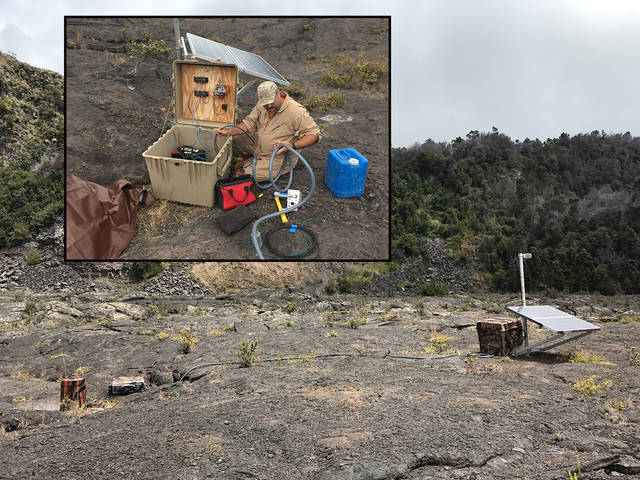Latest upgrade of seismic stations at Kīlauea summit completed

Field engineers at the U.S. Geological Survey Hawaiian Volcano Observatory recently completed a multi-year effort to upgrade a subset of seismic stations at the summit of Kilauea Volcano.
Starting in 2014, each of the stations was progressively upgraded with a new-generation broadband seismometer, solar-power system, radio, antenna, enclosure and cabling. The new enclosures for the seismometers were designed with better insulation properties to buffer the effects of changing temperatures throughout the day.
The latest upgrades are an important milestone for HVO. The stations ensure that Kilauea will remain a productive laboratory for the advancement of volcano seismicity. They will also continue to improve our understanding of the complex magma plumbing system beneath volcano’s summit area.
HVO’s original seismometers were installed in 1994 as a year-long field test of “broadband” seismometers — digital sensors that are more sensitive over a much greater frequency range than are the short-period analog seismometers that were widely used at the time. But the 1994 broadband instruments were kept past the one-year test period, because they proved crucial for recording many types of earthquake and volcanic signals that scientists were able to analyze in new ways.
Frequency is one way of describing the number of oscillations (peaks and troughs) of a seismic signal, typically measured in cycles per second, or Hertz. In volcano seismology, the dominant frequency of a seismic signal is related to different processes within the volcano.
For example, high frequency waves (greater than 1 Hz) recorded for normal earthquakes are typically related to slip on a fault. Low frequency waves (less than 1 Hz) for some earthquakes are related to the movement of magma or other mixtures of fluids and gases through fractures.
Broadband seismometers provide complete recordings of both high and low frequency waves coming from the volcano. The more commonly used short-period seismometers are tuned to record only high frequency waves.
The movement of magma under Kilauea generates a variety of low-frequency (often called Long-Period) and Very Long Period earthquakes with peak frequencies of 0.17 Hz or 60 seconds. The latter earthquakes, which can only be detected with broadband seismometers, were virtually invisible to the existing seismic network. The value of the dense broadband network became even more apparent when the summit eruption within Halema‘uma‘u began in 2008.
In 2009, the American Recovery and Reinvestment Act was enacted by Congress and signed into law by the President. This provided resources for HVO to convert the mixed analog and digital monitoring network to an all-digital network — a first for a U.S. volcano observatory.
With ARRA funding, HVO purchased new field-hardened computers (called digitizers) to record seismic signals on-site and digital radios to transmit the data in real time to HVO. The digitizers significantly expanded the useful dynamic range of the original broadband network. This added capability was important for characterizing the mechanism that generates seismic signals associated with large rockfalls into the summit lava lake. Scientists also are using the expanded seismic signals to develop models of the short-term rise and fall of the lava lake surface related to the accumulation and release of volcanic gas in the uppermost part of the lava lake.
It became clear in about 2011 that the harsh environmental conditions in Kilauea’s summit caldera were taking a toll on the aging seismometers. The instruments were corroding inside and outside, leading to inconsistent measurements of ground shaking. Some sensors were failing. So, starting in 2014, HVO placed a priority on improving the summit broadband network, and the stations were upgraded in phases as resources allowed.
This upgraded network reflects state-of-the-art earthquake monitoring, and offers volcano seismologists a more powerful tool to investigate processes that cause ground shaking at Kilauea. This in turn supports advances in our understanding of the volcano’s magma plumbing system, eruptive activity, and hazards.
For additional information about HVO’s broadband seismic network, see this 2011 Volcano Watch article: https://volcanoes.usgs.gov/hvo/hvo_volcano_watch.html?vwid=81. A former HVO seismologist describes highlights of recent research on Kilauea seismic activity in a video presentation, “Several flavors of seismogenic magma movement under Kilauea Volcano,” posted at https://www.youtube.com/playlist?list=PLD4D607C2FA317E6D.
Volcano Watch is a weekly article and activity update written by U.S. Geological Survey Hawaiian Volcano Observatory scientists.
Volcano Activity Updates
This past week, Kilauea Volcano’s summit lava lake fluctuated in concert with summit inflation and deflation, with levels ranging around 69-121 feet below the vent rim. On the East Rift Zone, the 61g flow remained active, with lava entering the ocean near Kamokuna and scattered surface breakouts downslope of Pu‘u ‘O‘o. These flows do not pose an immediate threat to nearby communities.
Mauna Loa is not erupting. During the past week, small-magnitude earthquakes were recorded mostly from beneath the summit caldera and upper Southwest Rift Zone at depths about 1-2 miles. Microearthquakes also occurred on the east flank at depths of 3-8 miles. GPS measurements continue to show deformation consistent with inflation of a magma reservoir beneath the summit and upper Southwest Rift Zone. No significant changes in volcanic gas emissions were measured.
Four earthquakes were reported felt on the Island of Hawaii this past week. At 7:01 a.m. on June 8, a magnitude-5.3 earthquake occurred 11 miles southeast of Volcano at a depth of 4 miles. At 5:08 p.m. on June 7, a magnitude-3.4 earthquake occurred 7 miles west of Kalaoa at a depth of 9 miles. At 1 p.m. on June 7, a magnitude-3.3 earthquake occurred 2 miles southwest of Captain Cook at a depth of 7 miles. At 9:23 a.m. on June 6, a magnitude-2.7 earthquake occurred 13 miles west of Kailua-Kona at a depth of 24 miles.
Visit https://volcanoes.usgs.gov/hvo for past Volcano Watch articles, Kilauea daily eruption updates, Mauna Loa weekly updates, volcano photos, recent earthquakes info, and more. Call for summary updates at 967-8862 (Kilauea) or 967-8866 (Mauna Loa). Email questions to askHVO@usgs.gov.


